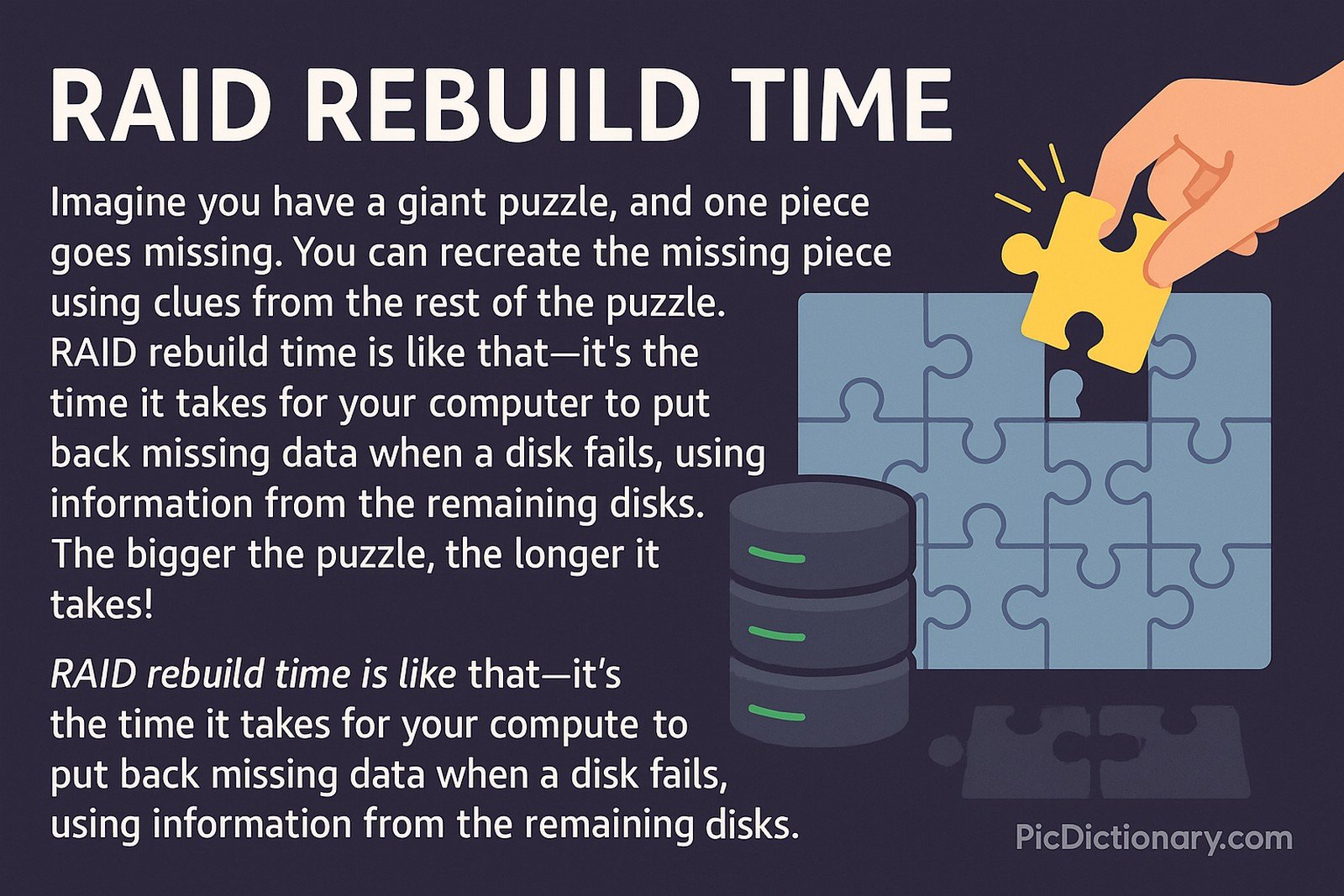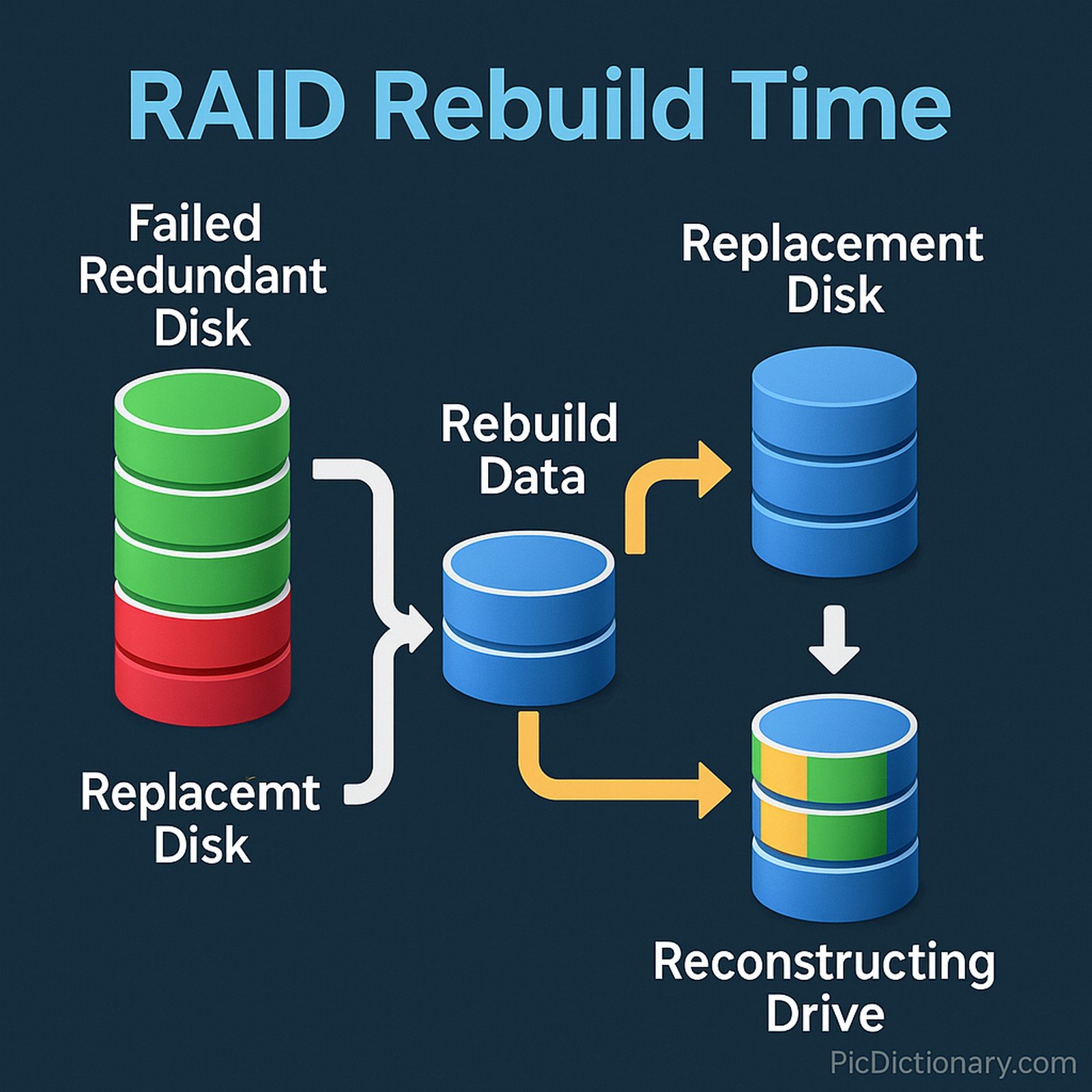RAID Rebuild Time
 (Representational Image | Source: Dall-E)
(Representational Image | Source: Dall-E)
Quick Navigation:
- RAID Rebuild Time Definition
- RAID Rebuild Time Explained Easy
- RAID Rebuild Time Origin
- RAID Rebuild Time Etymology
- RAID Rebuild Time Usage Trends
- RAID Rebuild Time Usage
- RAID Rebuild Time Examples in Context
- RAID Rebuild Time FAQ
- RAID Rebuild Time Related Words
RAID Rebuild Time Definition
RAID rebuild time refers to the duration required to reconstruct a failed disk in a RAID (Redundant Array of Independent Disks) setup. When a disk in a RAID array fails, the system restores data onto a replacement drive by recalculating and redistributing information from the remaining functional drives. The rebuild process depends on factors such as RAID level, disk size, disk speed, and system load. A longer rebuild time increases the risk of data loss if another disk fails before the process completes.
RAID Rebuild Time Explained Easy
Imagine you have a giant puzzle, and one piece goes missing. You can recreate the missing piece using clues from the rest of the puzzle. RAID rebuild time is like that—it’s the time it takes for your computer to put back missing data when a disk fails, using information from the remaining disks. The bigger the puzzle, the longer it takes!
RAID Rebuild Time Origin
The concept of RAID rebuild time emerged with the advent of RAID storage in the late 1980s. As RAID technology evolved, higher-capacity drives increased the time required to rebuild data when a disk failed. The need for optimized rebuild processes grew with storage demand.
RAID Rebuild Time Etymology
The term “RAID rebuild time” derives from the RAID (Redundant Array of Independent Disks) concept, with “rebuild” referring to the restoration process and “time” indicating the duration required for this operation.
RAID Rebuild Time Usage Trends
With increasing hard drive capacities and the adoption of SSDs, RAID rebuild times have become a critical concern for IT professionals. As RAID arrays grow larger, the rebuild process can take several hours or even days, posing risks of secondary failures. The introduction of RAID alternatives like erasure coding and advanced parity protection mechanisms has aimed to mitigate these risks.
RAID Rebuild Time Usage
- Formal/Technical Tagging:
- Storage Management
- Data Recovery
- RAID Systems - Typical Collocations:
- "RAID rebuild time optimization"
- "reducing RAID rebuild time"
- "long RAID rebuild process"
- "RAID array recovery speed"
RAID Rebuild Time Examples in Context
- A system administrator noticed that RAID rebuild time increased significantly when using larger hard drives.
- To minimize downtime, IT teams employ faster drives and backup solutions to reduce RAID rebuild time.
- RAID rebuild time is a key factor in selecting storage solutions for enterprise data centers.
RAID Rebuild Time FAQ
- What is RAID rebuild time?
RAID rebuild time is the time it takes to restore a failed disk in a RAID array. - Why does RAID rebuild time vary?
It depends on disk size, RAID level, system load, and drive speed. - How long does RAID rebuild time usually take?
It can take anywhere from a few hours to several days, depending on the system. - Does RAID rebuild time affect performance?
Yes, it can slow down system operations during the rebuild process. - Can RAID rebuild time be reduced?
Yes, by using faster disks, SSDs, and optimized RAID controllers. - Which RAID levels have the fastest rebuild time?
RAID 1 and RAID 10 typically have faster rebuild times than RAID 5 and RAID 6. - What happens if another disk fails during RAID rebuild?
In most cases, data loss occurs unless additional redundancy is in place. - Are SSDs better for RAID rebuild time?
Yes, SSDs have faster data transfer speeds, reducing rebuild times significantly. - What role does system workload play in RAID rebuild time?
Higher system workloads can slow down the rebuild process. - Is RAID rebuild time a concern for home users?
It depends on storage needs, but enterprise systems are more impacted.

RAID Rebuild Time Related Words
- Categories/Topics:
- Data Storage
- IT Infrastructure
- Disaster Recovery
Did you know?
A RAID rebuild can take longer than expected due to background system activity. Some enterprise setups implement hot spares—pre-installed backup drives that immediately take over when a failure occurs, significantly reducing rebuild time.
PicDictionary.com is an online dictionary in pictures. If you have questions or suggestions, please reach out to us on WhatsApp or Twitter.Authors | Arjun Vishnu | @ArjunAndVishnu

I am Vishnu. I like AI, Linux, Single Board Computers, and Cloud Computing. I create the web & video content, and I also write for popular websites.
My younger brother, Arjun handles image & video editing. Together, we run a YouTube Channel that's focused on reviewing gadgets and explaining technology.



Comments powered by CComment